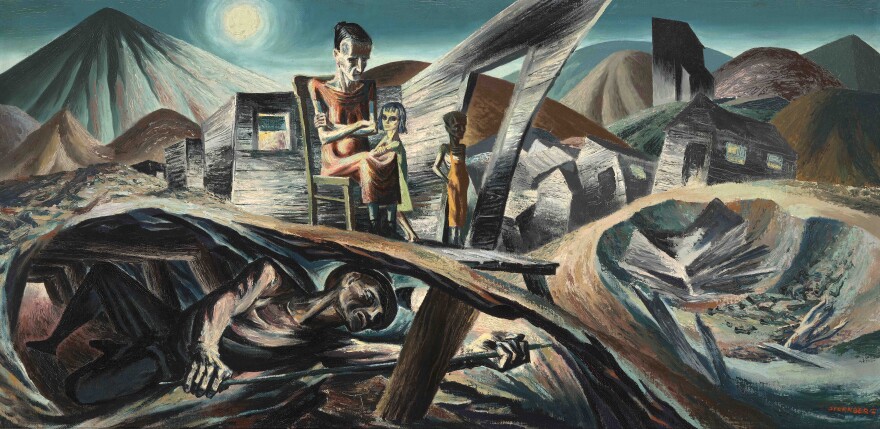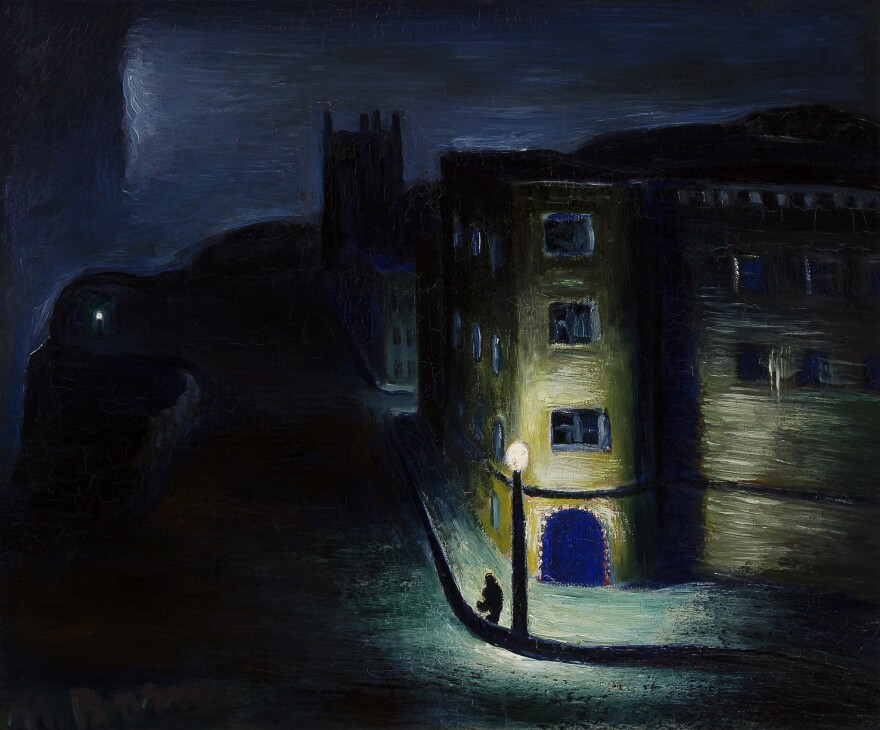Oceanside Museum of Art (OMA) is currently hosting "Art For The People: WPA-Era Paintings from the Dijkstra Collection."
The exhibit features works created during the Great Depression of the 1930s through World War II.
Art collector Bram Dijkstra has a good eye for art as well as a bargain.

Panel Talk: Art in Times of Crisis
Oct. 7, 2:00 p.m.
Inspired by OMA's exhibition Art for the People: WPA-Era Paintings from the Dijkstra Collection, this panel will offer an insightful look at art created within the socio-political conditions of the 1930s, and to consider how these works offer relevance today. Scott A. Shields, Ted and Melza Barr Chief Curator and Associate Director at the Crocker, is joined by Bram Dijkstra (Professor Emeritus of American and Comparative Literature Ph.D. at UC San Diego); Henry Adams (Ruth Coulter Heede Professor of Art History at Case Western University); and independent curator Susan M. Anderson.
"This is a part of what we used to call our collection of discarded art," Dijkstra said.
The art he’s referring to was part of the government sponsored Works Progress Administration or WPA, which gave artists a weekly stipend in exchange for art. But thousands of artists regularly creating work for years left the U.S. government with more art than it could manage.
"The exhibit is essentially the result of about 40 years of collecting work that was basically being thrown out by a lot of different places," Dijkstra explained.
Sandra Dijkstra, Bram's wife, said that many of the artists were politically aware.
"Because they were politically engaged, both the professional art establishment and the government did not welcome them," she said. "Their art was described as 'social realism,' by which they really meant 'socialist' realism. And so this art was not only discarded, it was actually dissed and denigrated."

But the Dijkstras saw value in these works that were intended to be both accessible and meaningful to the public.
"Art for the people was obviously not what the museums wanted in the 80s and 90s, and not until fairly recently," Bram said.
But Oceanside Museum of Art was interested. It’s showcasing 45 paintings from the Dijkstras' collection for the exhibit, "Art For The People: WPA-Era Paintings."
"Our museum currently doesn't have a very large permanent collection," explained OMA's executive director Maria Mingalone. "So we put on a number of temporary exhibitions that we augment with work from collectors, from artists themselves, from gallerists, and other museums. So collectors are really part of the spine, if you will, or the heart and soul of a museum."
Mingalone appreciates the diversity of the Dijkstra collection and how it resonates for today’s challenging times.
"The work that's in this exhibition was made during similar times, and I think that it speaks to sort of what we've been experiencing," Mingalone said. "And it adds that certain sense of humanity, of understanding what we and people go through when times aren't so great."

Many of these paintings emphasize that humanity by focusing on the human figure as in Harry Sternberg’s bold and powerful "Coal Miner and Family," in which we see a miner forced to dig under his own home, endangering his family above.
"It's both a critical painting and a painting in which the artist resolves a very complex compositional structure," Bram said.
Many of these painters were critiquing America with a keen eye.
"One of the objectives of this collection and the show was to bring back the political dimension but to also show the art of the period included many different things," Sandra said.
That diversity and social commentary are evident in the provocative and surreal "New Death" painted by Philip Evergood and depicting the Atom Bomb.

"What is fascinating about his work is that it's never social realism," Bram said. "It is always very phantasmagoric," Sandra said. "The way these characters, who are basically capitalists, are being caught up in the new death of the Atom Bomb and the destructive impulses of the Atom Bomb, which are identified here in the skulls at the bottom, and those are presented by all these terrible tentacles that seem to come out of nowhere and go nowhere. There is a sense of a spidery world, and in that spidery world, it's not just the people who are plotting the destruction of the world, but also all of humanity, you might say, is being caught up, destroyed."

The intense, thick, and deceptively chaotic texture of the paint in "New Death" contrasts dramatically with Edward Biberman’s "Slow Turn," which Bram noted, "has no texture, officially no texture. But the texture is there in the sense that the road becomes the texture."
"This is Mulholland Drive in L.A. And he's showing all the cracks in the road and are you going to fall off a cliff when you drive down that road?" Sandra added. "This is one of those paintings, in which there is an implicit political message as opposed to explicit because this is 1945 and there's a very ominous black plane up there. Some of the viewers have said this is California noir."
The Dijkstras are proud to highlight California art in the exhibit because it is often overlooked when showcasing WPA art. They also made a point of including women artists such as Helen Appleton Read, Florence Ballin Cramer, Isabel Bishop, and Helen Forbes.

The exhibit serves up a contrasts of styles, subjects and colors. Conrad Buff's "Red Arch Mountain, Zion National Park, Utah" serves up a landscape set aglow by the hot sun whereas Matthew Barnes' "Mission Church" presents a lonely figure on a city street where a single light holds back the encroaching blackness of night.
But the use of light by the artists needs the right setting to make it shine.
"One of the things that really makes a painting speak is the light that falls on it," Bram said. "And the artist hopes that the light will be there, and not just to see the brushstroke, but feel the brushstroke. When you go around this exhibition, there are so many different textures, from very thick textures to almost no texture at all. And artists have purposes for that — no texture or thick texture — and that, again, relates to the way in which we experience a painting."

And the best way to experience a painting is by seeing the authentic object.
"You can experience things in print or in digital formats," Mingalone said. "But there is nothing like literally being in front of a painting or in front of a work of art, and the experience that you have is intangible."
The Dijkstra collection serves up a diverse array of breathtaking art that has not always received the appreciation it deserves. "Art For The People: WPA-Era Paintings" celebrates this art.
OMA's hours, ticket information and directions can be found here. "Art For The People: WPA-Era Paintings from the Dijkstra Collection" runs through Nov. 5 at OMA and then moves to the Huntington Library, Art Museum and Botanical Gardens in December.





